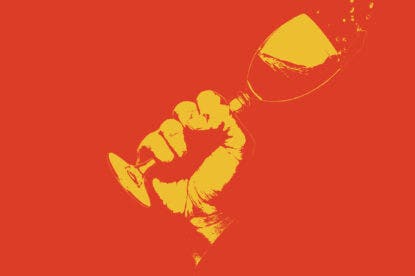Lees aging, also known as sur lie, which is French for “on lees,” is the process of letting white and sparkling wines mature and age on top of spent yeast and other particulate matter. A sedimentary byproduct of fermentation, lees have a milky appearance and smooth consistency. While prolonged contact with lees can negatively impact the taste of some wines, in others, lees provide recognizable and beloved characteristics.
Through this process, the wines develop rounded mouthfeel, creamy flavors and yeasty, bread-like notes. This winemaking method is commonly associated with Burgundian winemaking and used for grapes like Chardonnay and Muscadet in the Loire. Perhaps the most well-known example of this style of wine is Champagne, which must be aged on its lees from 12 months to 36 months depending on the vintage and type.
This style of winemaking is also used in the U.S., often with oak-aged California Chardonnay, to achieve its iconic warm, buttery and creamy qualities.
“To have good lees, you have to have good grapes,” says Cara Morrison, Chardonnay winemaker at California’s Sonoma-Cutrer. The producer is known for its use of traditional Burgundian sur lie aging techniques, including barrel fermentation, sur lie and bâttonage.
But how does letting a wine age and rest on fine lees create these flavors and mouthfeel?
After yeast has consumed and converted the sugar in a wine, it dies. Inside the dead yeast cells are a plethora of important compounds, proteins and molecules like mannoproteins, polysaccharides, fatty acids and amino acids.
Mannoproteins are protein groups that add mouthfeel, aroma, flavor and soften tannins. Polysaccharides, which are bonded groups of sugar molecules, can reduce the astringency of tannins and create balance and structure in the body of the wine. Fatty acids, which are contained within the cell walls of the yeast, help boost various flavors and aromas. Amino acids have a similar impact, along with the ability to improve texture.
Lees aging takes place once the wine is in barrel or bottle. But the interaction between the lees and the barrel is also essential, especially for white wines like Chardonnay.
“It takes the compounds from the oak and immigrates it into the wine,” says Morrison of Sonoma-Cutrer’s use of oak barrels for aging, which it does in tandem with sur lie.
Different lees molecules come into play at various points in the aging and maturing process. During the early stages, usually the first few months, the main benefit of lees aging is to prevent unwanted oxidation in the developing wine. The mannoproteins absorb residual oxygen that could cause undesired oxidation and dull both the color and flavor.
The presence of mannoproteins is also crucial for white wines like Chardonnay that go through malolactic fermentation, where the malic acid in a wine converts to lactic acid and creates a buttery or creamy taste. The malolactic bacteria eat the mannoproteins, aiding the process.
After the first few months, the dead yeast cells break down through autolysis and start to release their compounds into the wine. This is when the magic happens, and when the winemaker can start to use the lees to shape the character of the wine. This is typically done through bâttonage, where a metal baton is inserted into a barrel of wine and stirred, releasing a cloud of lees.
“It’s like cream in coffee or a lava lamp,” says Morrison.
By stirring the lees instead of simply letting them sit at the bottom of the barrel for the entire aging period, winemakers can create more uniform interactions with the wine in the barrel. It breaks down the yeast cell walls more quickly to release compounds into the wine.
How many times the lees are stirred depends on the winemaker and wine. Morrison tends to stir lees about once a month for each seven-to-nine-month barrel-aging period. “You don’t want to over-stir or under-stir,” says Morrison. “Like Goldilocks, you want it just right.”
Many Champagne producers value sur lie for the roundness, aromas and flavors it imparts. Since Champagne completes its secondary fermentation in the bottle, however, the lees don’t rest in the bottom of the barrel. Instead, individual bottles are rotated during the aging process, and then slowly angled so the lees collect in the neck to be removed at the end of the aging period—a process known as riddling.
Published: June 10, 2022















